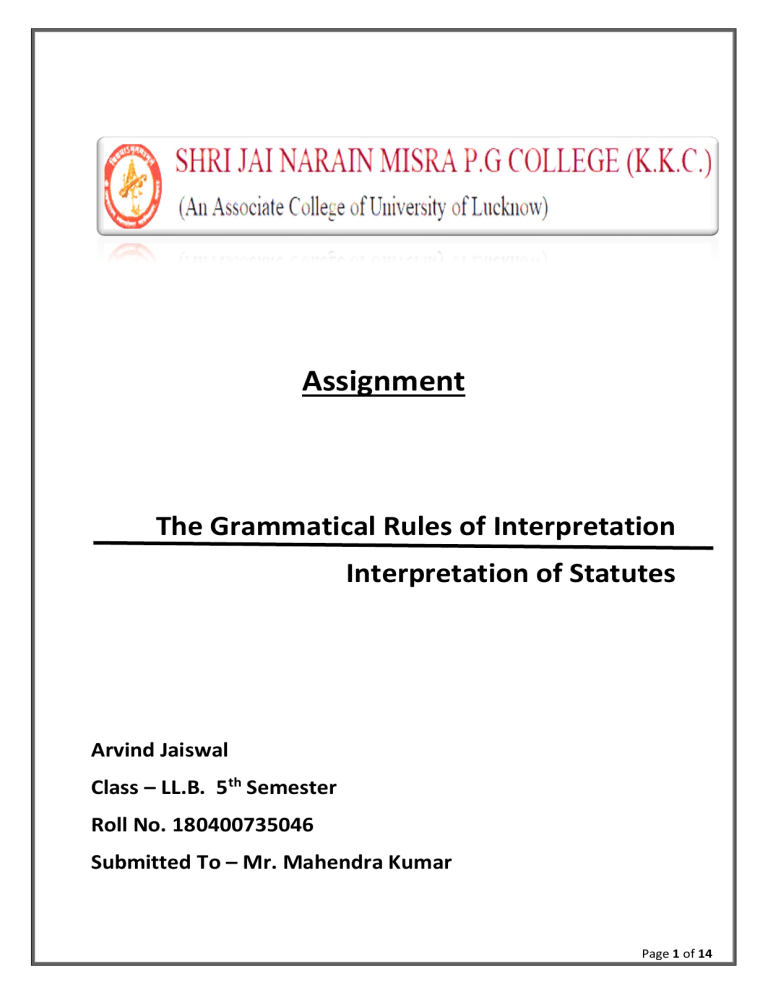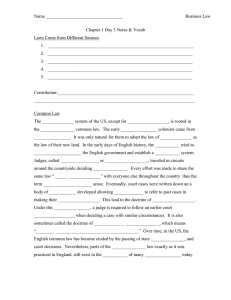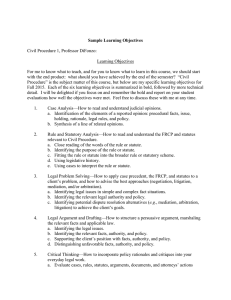
Assignment The Grammatical Rules of Interpretation Interpretation of Statutes Arvind Jaiswal Class – LL.B. 5th Semester Roll No. 180400735046 Submitted To – Mr. Mahendra Kumar Page 1 of 14 INTRODUCTION The term Interpretation has been derived from the Latin term “interpretari” which means to explain or understand. Every statute has to be interpreted by the judge the way it is meant to be understood. A "Statute" is the will of the sovereign legislature according to which the governments function. The executive must act and the judiciary in the course of administration of justice must apply the law as laid down by the said legislative will. Very often occasions will arise where the courts will be called upon to interpret the words, phrases and expressions used in the statute. In the course of such interpretation, the Courts have, over the centuries, laid down certain guidelines which have come to be known as "Rules of Interpretation of Statutes".1 More often than not the Statutes contain "Statement of Objects and Reasons" and also a "Preamble" both of which provide guidelines for Interpreting the true meaning of the words and expressions used in the Statute.2 “By interpretation or construction is meant”, says Salmond: “the process by which the court seek to ascertain the meaning of the legislature through the medium of authoritative forms in which it is expressed”.3 The purpose of interpretation is always to find out what the statute stands for, what is the defect it intends to remove and what is the remedy it seeks to advance.4 The basic principle of the construction of statutes is that, the words have to be read and understood in their true literal sense. The Literal Rule is the first rule applied Page 2 of 14 by the judges. The literal rule is also called grammatical rule by some jurists. Interpretation is of two kinds - grammatical and logical. Grammatical interpretation is arrived at by the reference to the laws of speech to the words used in the statute; in other words, it regards only the verbal expression of the legislature. Logical interpretation gives effect to the intention of the legislature by taking into account other circumstances permissible according to the rules settled in this behalf.11 There are three major rules of interpretation of statutes. They are: Literal Rule Golden Rule Mischief Rule Literal Interpretation of a statute is finding out the true sense by making the statute its own expositor.5 LITERAL RULE OF INTERPRETATION OF STATUTES In construing Statutes, the cardinal rule is to construe its provisions literally and grammatically giving the words their ordinary and natural meaning. This rule is also known as the Plain meaning rule. The First and foremost step in the course of interpretation is to examine the language and the literal meaning of the statute. The words in an enactment have their own natural effect and the construction of an act depends on its wording. There should be no additions or substitution of words in the construction of statutes and in its interpretation. The primary rule is Page 3 of 14 to interpret words as they are. It should be taken into note that the rule can be applied only when the meanings of the words are clear i.e. words should be simple so that the language is plain and only one meaning can be derived out of the statute. In Municipal board vs. State transport authority, Rajasthan, the location of a bus stand was changed by the Regional Transport Authority. An application could be moved within 30 days of receipt of the order of regional transport authority according to section 64 A Motor vehicles Act, 1939. The application was moved after 30 days on the contention that statute must be read as “30 days from the knowledge of the order”. The Supreme Court held that literal interpretation must be made and hence rejected the application as invalid. Lord Atkinson stated, ‘In the construction of statutes their words must be interpreted in their ordinary grammatical sense unless there be something in the context or in the object of the statute in which they occur or in the circumstances in which they are used, to show that they were used in a special sense different from their ordinary grammatical sense.’ Meaning To avoid ambiguity, legislatures often include “definitions” sections within a statute, which explicitly define the most important terms used in that statute. But some statutes omit a definitions section entirely, or (more commonly) fail to define a particular term. The plain meaning rule attempts to guide courts faced with litigation that turns on the meaning of a term not defined by the statute, or on that of a word found within a definition itself. If the words are clear, they must be Page 4 of 14 applied, even though the intention of the legislator may have been different or the result is harsh or undesirable. The literal rule is what the law says instead of what the law means. A literal construction would not be denied only because the consequences to comply with the same may lead to a penalty. The courts should not be overzealous in searching for ambiguities or obscurities in words which are plain. Tata Consultancy Services vs. State of A.P 6 The literal rule may be understood subject to the following conditions – Statute may itself provide a special meaning for a term, which is usually to be found in the interpretation section. Technical words are given ordinary technical meaning if the statute has not specified any other. Words will not be inserted by implication. Words undergo shifts in meaning in the course of time. It should always be remembered that words acquire significance from their context. When it is said that words are to be understood first in their natural ordinary and popular sense, it is meant that words must be ascribed that natural, ordinary or popular meaning which they have in relation to the subject matter with reference to which and the context in which they have been used in the Statute. In the statement of the rule, the epithets ‘natural, “ordinary”, “literal”, “grammatical” and “popular” are employed almost interchangeably to convey the same idea. Page 5 of 14 For determination of the meaning of any word or phrase in a statute, the first question is what is the natural and ordinary meaning of that word or phrase in its context in the statute but when that natural or ordinary meaning indicates such result which cannot be opposed to having been the intention of the legislature, then to look for other meaning of the word or phrase which may then convey the true intention of the legislature. Another important point regarding the rule of literal construction is that exact meaning is preferred to lose meaning in an Act of Parliament. In the case of Pritipal Singh vs. Union of India 7, it was held that there is a presumption that the words are used in an Act of Parliament correctly and exactly and not loosely and inexactly. Rationale for this Rule Proponents of the plain meaning rule claim that it prevents courts from taking sides in legislative or political issues. They also point out that ordinary people and lawyers do not have extensive access to secondary sources. In probate law, the rule is also favoured because the testator is typically not around to indicate what interpretation of a will is appropriate. Therefore, it is argued, extrinsic evidence should not be allowed to vary the words used by the testator or their meaning. It can help to provide consistency in interpretation. Criticism of this rule Opponents of the plain meaning rule claim that the rule rests on the erroneous assumption that words have a fixed meaning. In fact, words are imprecise, leading justices to impose their own prejudices to determine the meaning of a Page 6 of 14 statute. However, since little else is offered as an alternative discretion-confining theory, plain meaning survives. This is the oldest of the rules of construction and is still used today, primarily because judges may not legislate. As there is always the danger that a particular interpretation may be the equivalent of making law, some judges prefer to adhere to the law’s literal wording. Merits/Advantages of the Rule of Literal Construction • When the rule of grammatical interpretation (literal construction) is applied, there is no scope for the judges to express their own opinion pre judices to interfere. • The rule of literal interpretation respects parliamentary supremacy and upholds separation of power. Demerits/Disadvantages of the Rule of Literal Construction/Grammatical Interpretation • It fails to recognize that English language used in the statutes, itself is ambiguous and the English words contain different meanings from context to context. • The rule of literal construction ignores the limitations of language. Golden Rule of Interpretation One of the three basic rules of interpretation, construction is ‘Golden Rule’. The Golden Rule of interpretation can be said as the modification of the Grammatical Rule of Interpretation. It is also known as British Rule. It was originated in England in 1854 and was coined by C.J. in the case of: Page 7 of 14 Matterson vs. Hart 8 In this case, British Parliament applied the Golden Rule by giving the words used by the Legislature, their plain and natural meaning, unless injustice and absurdity would not result from so continuing them. This rule was named as ‘Golden Rule’ for the reason, it solves all problems. Circumstances leading to the application of the golden rule Golden rule gives the words in a statute, their plain ordinary meaning. If it leads to irrational result that is unlikely to be the legislature’s intention, the golden rule dictates that a judge can depart from this meaning. Where a word contains/conveys more than one meaning, the judge can choose the preferred meaning of his choice. If a word conveys only one meaning and application of the same leads to bad decision, then the judge can apply that word completely different meaning. The golden rule of interpretation is applied in two ways i.e. narrower and wider sense. The rule is applied more frequently in narrower sense, where there is some ambiguity or absurdity in the words themselves in the statute. Secondly, the golden rule is applied in the wider sense, to avoid obnoxious result to the principles of public policy, even where the words in a statute have only one meaning. The Golden Rule of Interpretation in India According to the Golden Rule, the courts in order to find out the intention of the legislature from the word used in the statute, give the words, their original and natural meaning. In case, it leads to any absurdity, repugnancy, inconvenience, hardship, injustice or evasion, the courts must modify the Page 8 of 14 meaning of the words in the statute to such an extent so as to prevent the consequences as a result of such absurdity hardship etc. Hence, the Golden Rule of interpretation is a modification in the rule of Grammatical Interpretation. The Supreme Court applied the golden rule of interpretation in- Golaknath vs. State of Punjab 9 In this case, the Supreme Court applied the golden rule of interpretation and held that the parliament cannot amend the constitution affecting the provisions under Part III (Fundamental Rights) of the constitution (and overruled the earlier decisions in Shankari Prasad’s case and Shajjah Singh’s case). The Mischief Rule The mischief rule is a rule of statutory interpretation that attempts to determine the legislator’s intention. Originating from a 16th-century case (Heydon’s case) in the United Kingdom, its main aim is to determine the “mischief and defect” that the statute in question has set out to remedy, and what ruling would effectively implement this remedy. When the material words are capable of bearing two or more constructions the most firmly established rule or construction of such words “of all statutes, in general, be they penal or beneficial, restrictive or enlarging of the common law”, is the rule of Heydon’s case. The rules laid down, in this case, are also known as Purposive Construction or Mischief Rule. Page 9 of 14 The mischief rule is a certain rule that judges can apply in statutory interpretation in order to discover Parliament’s intention. It essentially asks the question: By creating an Act of Parliament what was the “mischief” that the previous law did not cover? Heydon’s case 10 This was set out in Heydon’s Case10 where it was stated that there were four points to be taken into consideration when interpreting a statute: What was the common law before the making of the act? What was the “mischief and defect” for which the common law did not provide? What remedy the Parliament hath resolved and appointed to cure the disease of the common-wealth? What is the true reason for the remedy? The office of all the judges is always to make such construction as shall suppress the mischief, and advance the remedy, and suppress subtle inventions and evasions for the continuance of the mischief, and pro privato commodo, and to add force and life to the cure and remedy, according to the true intent of the makers of the Act, pro bono publico. The application of this rule gives the judge more discretion than the literal and the golden rule as it allows him to effectively decide on Parliament’s intent. It can be argued that this undermines Parliament’s supremacy and is undemocratic as it takes law making decisions away from the legislature. - Page 10 of 14 Use of this Rule This rule of construction is of narrower application than the golden rule or the plain meaning rule, in that it can only be used to interpret a statute and, strictly speaking, only when the statute was passed to remedy a defect in the common law. Legislative intent is determined by examining secondary sources, such as committee reports, treatises, law review articles and corresponding statutes. This rule has often been used to resolve ambiguities in cases in which the literal rule cannot be applied. In the case of Thomson vs. Lord Clan Morris 11, Lord Lindley M.R. stated that in interpreting any statutory enactment regard should not only be paid to the words used, but also to the history of the Act and the reasons which lead to its being passed. In the case of CIT vs. Sundaradevi12, it was held by the Apex Court that unless there is an ambiguity, it would not be open to the Court to depart from the normal rule of construction which is that the intention of the legislature should be primarily to gather from the words which are used. It is only when the words used are ambiguous that they would stand to be examined and considered on surrounding circumstances and constitutionally proposed practices. The Supreme Court in Bengal Immunity Co. vs. State of Bihar 13, applied the mischief rule in the construction of Article 286 of the Constitution of India. After referring to the state of law prevailing in the province prior to the constitution as also to the chaos and confusion that was brought about in Page 11 of 14 inter-state trade and commerce by the indiscriminate exercise of taxing powers by the different Provincial Legislatures founded on the theory of territorial nexus, Chief Justice S.R. Das, stated: “It was to cure this mischief of multiple taxations and to preserve the free flow of interstate trade or commerce in the Union of India regarded as one economic unit without any provincial barrier that the constitution maker adopted Article 286 in the constitution”. A principle to be valued must be capable of wider application than the mischief which gave it existence. These are designed to approach immortality as nearly as human institutions can approach it’. Mischief Rule is applicable where the language is capable of more than one meaning. It is the duty of the Court to make such construction of a statue which shall suppress the mischief and advance the remedy. Advantages The Law Commission sees it as a far more satisfactory way of interpreting acts as opposed to the Golden or Literal rules. It usually avoids unjust or absurd results in sentencing. Disadvantages It is considered to be out of date as it has been in use since the 16th century, when common law was the primary source of law and parliamentary supremacy was not established. Page 12 of 14 It gives too much power to the unelected judiciary which is argued to be undemocratic. In the 16th century, the judiciary would often draft acts on behalf of the king and were therefore well qualified in what mischief the act was meant to remedy. It can make the law uncertain. Conclusion Literal rule of interpretation is the primary rule. Under this rule of interpretation, the Courts interpret the statutes in a literal and ordinary sense. They interpret the words of the statute in a way that is used commonly by all. It is incumbent on the court to use the grammatical meaning. The statutes should be construed in such a manner as though there is no other meaning except the literal meaning. It is an old and traditional rule of interpretation. It is used not only in England where it originated but also in India. The Courts while interpreting statutes have to keep few things in mind. It must realize that a provision is ambiguous only if it contains a word or phrase which has more than one meaning. If the interpretation is open to different meanings in one context it is ambiguous but if it is susceptible to different meaning in different contexts it is plain. Page 13 of 14 Cases Referred: Bibliography 1. Aiyer P Ramnathan, LAW LEXICON, p.1134 (2nd ed., 2002). 2. Id. 3. P J Fitzgerald, SALMOND ON JURISPRUDENCE, p.153 (12th ed., 2008). 4. State of Jammu and Kashmir v. Thakur Ganga Singh [1960] 2 SCR 346, 351. 5. supra note 1. 6. Municipal board vs. State transport authority 2005 1 SCC 308 7. Tata Consultancy Services vs. State of A.P AIR 1982 SC 1413, P. 1419 8. Matterson vs. Hart (1854) 14 C.B. 357, at p. 385. 9. Golaknath vs. State of Punjab (AIR 1967 SC 1643) 10. Heydon’s case (1584) 76 ER 637 11. Thomson vs. Lord Clan Morris, 1900 12. CIT vs. Sundaradevi12 (1957) (32 ITR 615) (SC) 13. Bengal Immunity Co. vs. State of Bihar (AIR 1995 SC 661) Internet Sources Used: http://en.wikipedia.org/wiki/Plain_meaning_rule https://www.lawordo.com/basic-rules-of-interpretation https://definitions.uslegal.com/g/grammatical-interpretation/ http://www.legalserviceindia.com/legal/article-1730-the-literal-rule-of-interpretation-of statute.html www.westlaw.com Page 14 of 14


